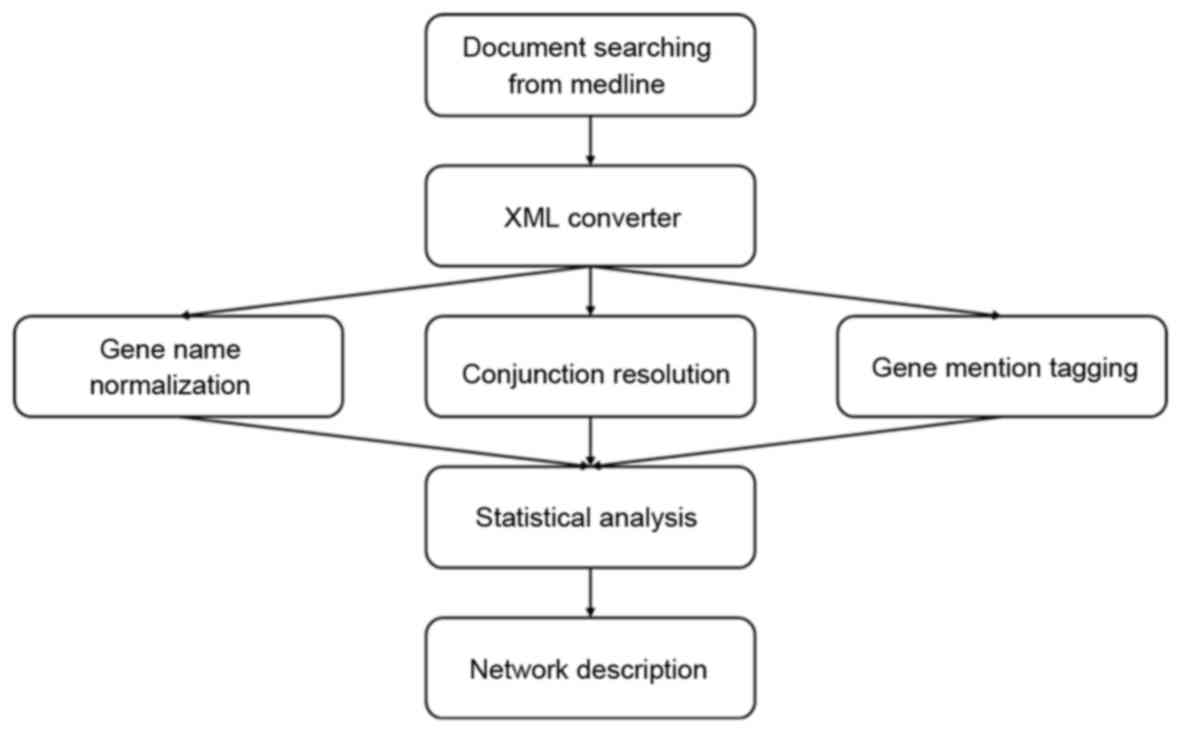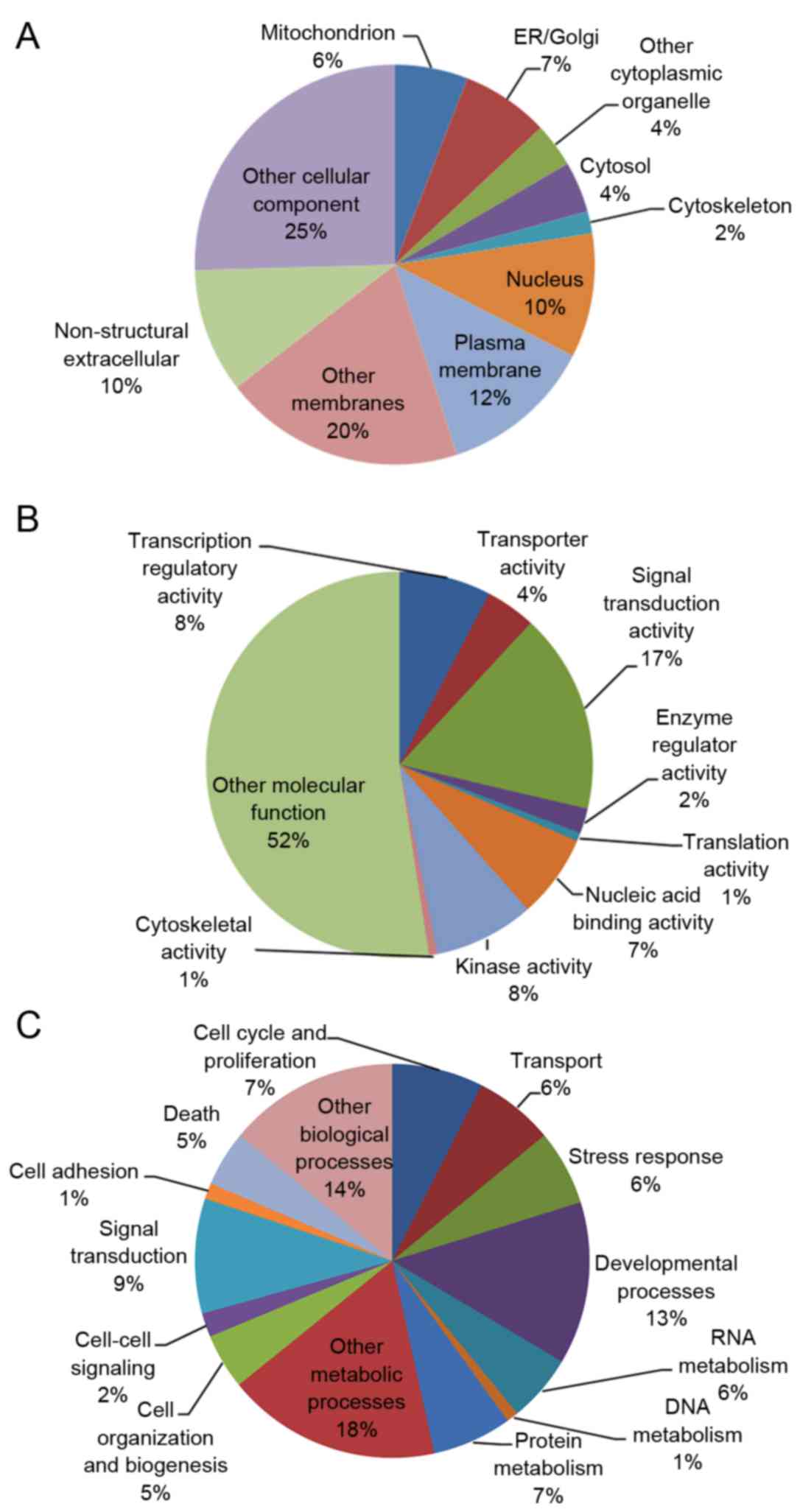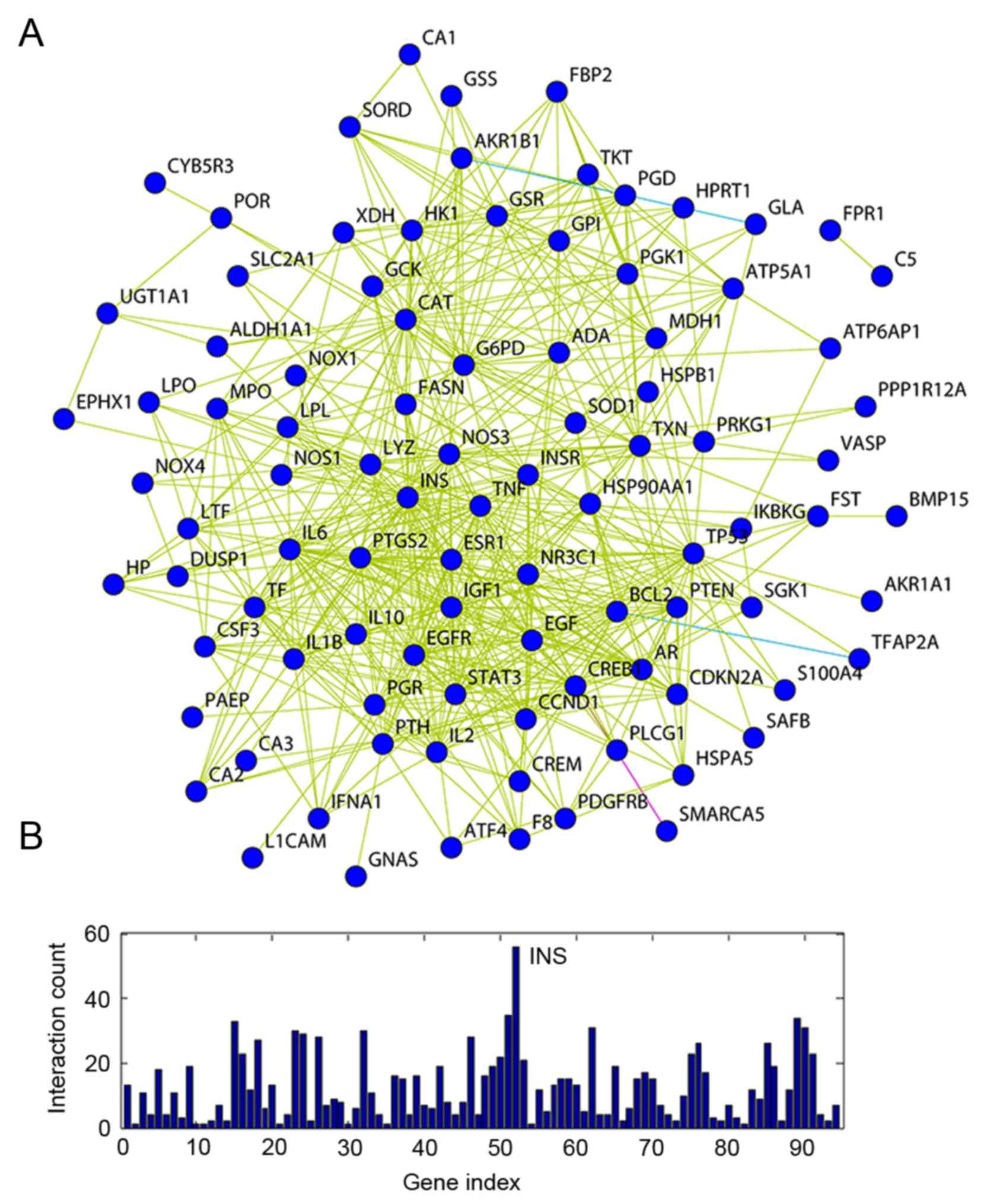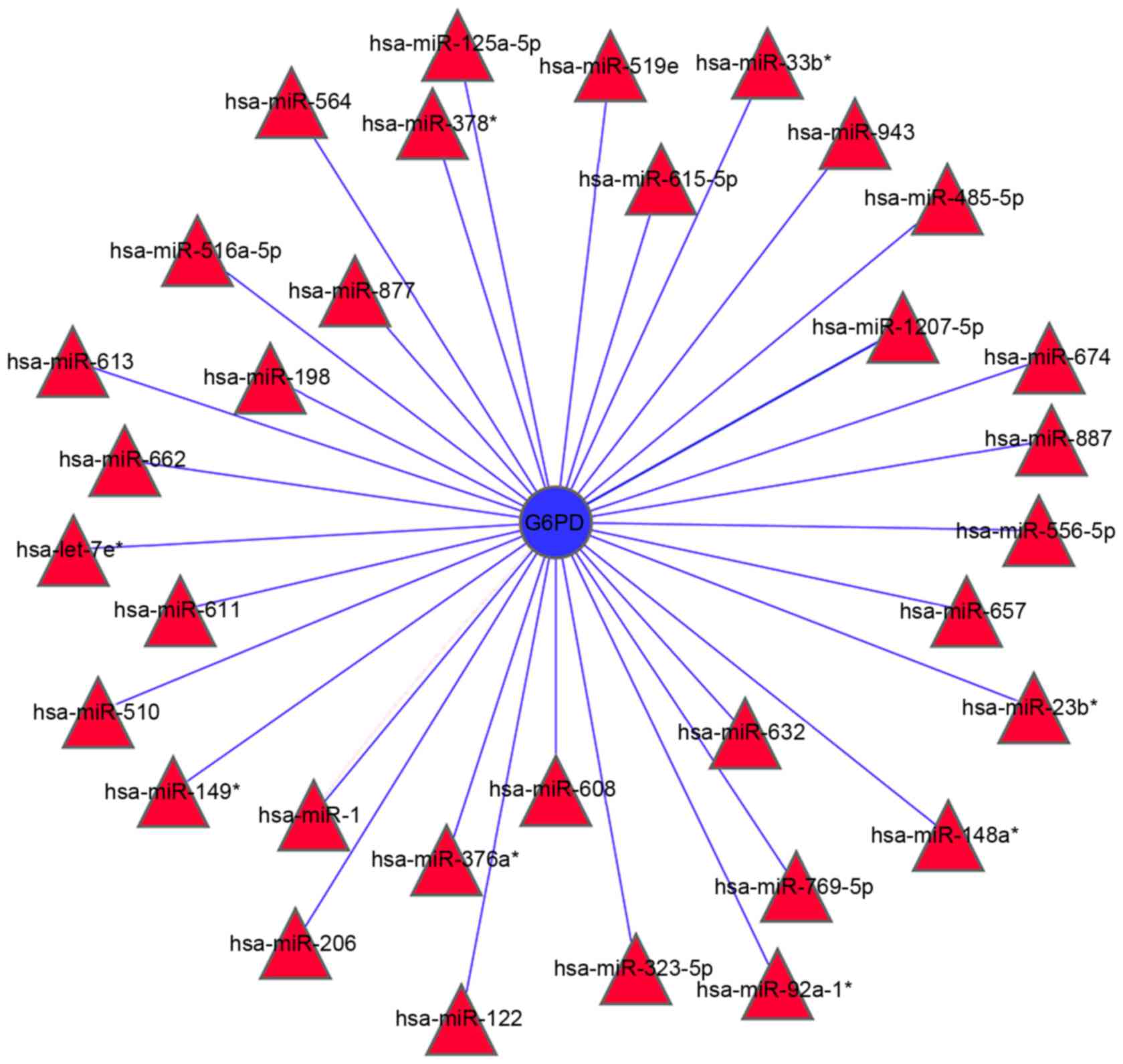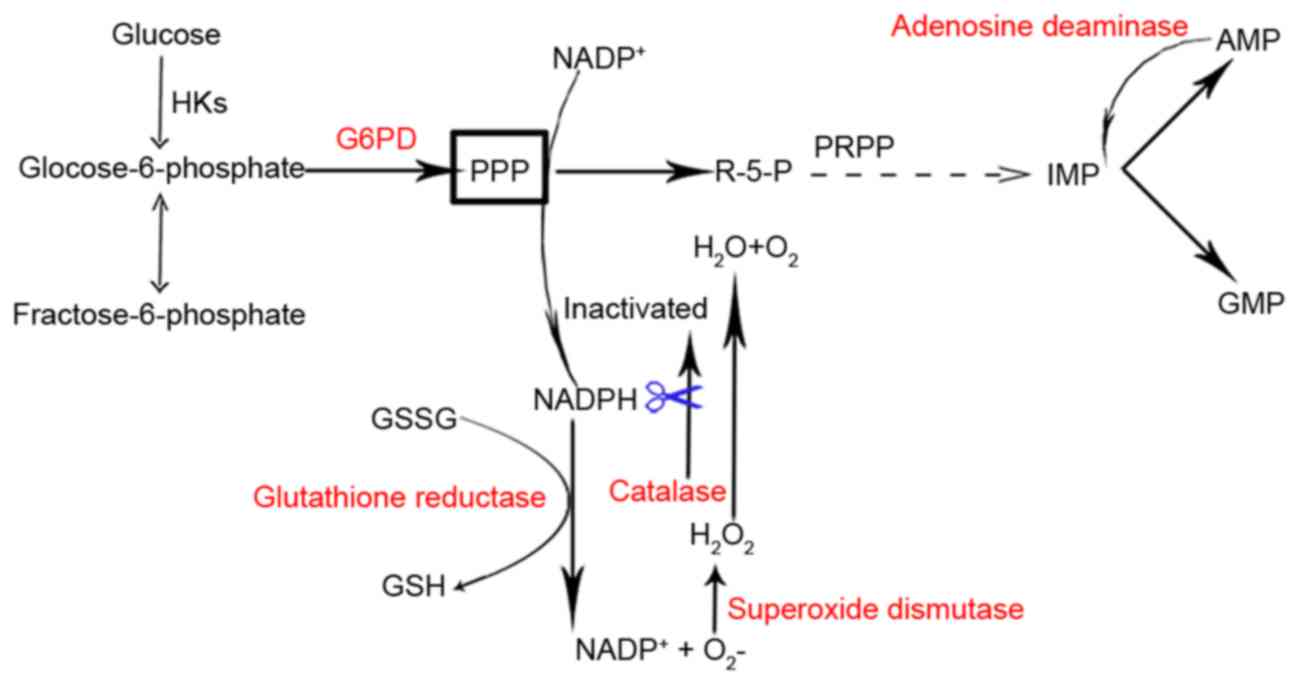|
1
|
Carson PE and Frischer H:
Glucose-6-phosphate dehydrogenase deficiency and related disorders
of the pentose phosphate pathway. Am J Med. 41:744–761. 1966.
View Article : Google Scholar : PubMed/NCBI
|
|
2
|
Lewis CA, Parker SJ, Fiske BP, McCloskey
D, Gui DY, Green CR, Vokes NI, Feist AM, Heiden MG Vander and
Metallo CM: Tracing compartmentalized NADPH metabolism in the
cytosol and mitochondria of mammalian cells. Mol Cell. 55:253–263.
2014. View Article : Google Scholar : PubMed/NCBI
|
|
3
|
Glucose-6-phosphate dehydrogenase
deficiency. WHO Working Group. Bull World Health Organ. 67:601–611.
1989.PubMed/NCBI
|
|
4
|
Cappellini MD and Fiorelli G:
Glucose-6-phosphate dehydrogenase deficiency. Lancet. 371:64–74.
2008. View Article : Google Scholar : PubMed/NCBI
|
|
5
|
Wang YP, Zhou LS, Zhao YZ, Wang SW, Chen
LL, Liu LX, Ling ZQ, Hu FJ, Sun YP, Zhang JY, et al: Regulation of
G6PD acetylation by SIRT2 and KAT9 modulates NADPH homeostasis and
cell survival during oxidative stress. EMBO J. 33:1304–1320.
2014.PubMed/NCBI
|
|
6
|
WHO Working Group, . Glucose-6-phosphate
dehydrogenase deficiency. Bull World Health Organ. 67:601–611.
1989.PubMed/NCBI
|
|
7
|
Tian WN, Braunstein LD, Apse K, Pang J,
Rose M, Tian X and Stanton RC: Importance of glucose-6-phosphate
dehydrogenase activity in cell death. Am J Physiol.
276:C1121–C1131. 1999.PubMed/NCBI
|
|
8
|
Ho HY, Cheng ML, Lu FJ, Chou YH, Stern A,
Liang CM and Chiu DT: Enhanced oxidative stress and accelerated
cellular senescence in glucose-6-phosphate dehydrogenase
(G6PD)-deficient human fibroblasts. Free Radic Biol Med.
29:156–169. 2000. View Article : Google Scholar : PubMed/NCBI
|
|
9
|
Pandolfi PP, Sonati F, Rivi R, Mason P,
Grosveld F and Luzzatto L: Targeted disruption of the housekeeping
gene encoding glucose 6-phosphate dehydrogenase (G6PD): G6PD is
dispensable for pentose synthesis but essential for defense against
oxidative stress. EMBO J. 14:5209–5215. 1995.PubMed/NCBI
|
|
10
|
Longo L, Vanegas OC, Patel M, Rosti V, Li
H, Waka J, Merghoub T, Pandolfi PP, Notaro R, Manova K and Luzzatto
L: Maternally transmitted severe glucose 6-phosphate dehydrogenase
deficiency is an embryonic lethal. EMBO J. 21:4229–4239. 2002.
View Article : Google Scholar : PubMed/NCBI
|
|
11
|
Kuo W, Lin J and Tang TK: Human
glucose-6-phosphate dehydrogenase (G6PD) gene transforms NIH 3T3
cells and induces tumors in nude mice. Int J Cancer. 85:857–864.
2000. View Article : Google Scholar : PubMed/NCBI
|
|
12
|
Cappai G, Songini M, Doria A, Cavallerano
JD and Lorenzi M: Increased prevalence of proliferative retinopathy
in patients with type 1 diabetes who are deficient in
glucose-6-phosphate dehydrogenase. Diabetologia. 54:1539–1542.
2011. View Article : Google Scholar : PubMed/NCBI
|
|
13
|
Heymann AD, Cohen Y and Chodick G:
Glucose-6-phosphate dehydrogenase deficiency and type 2 diabetes.
Diabetes Care. 35:e582012. View Article : Google Scholar : PubMed/NCBI
|
|
14
|
Gaskin RS, Estwick D and Peddi R: G6PD
deficiency: Its role in the high prevalence of hypertension and
diabetes mellitus. Ethn Dis. 11:749–754. 2001.PubMed/NCBI
|
|
15
|
Rao KN, Elm MS, Kelly RH, Chandar N, Brady
EP, Rao B, Shinozuka H and Eagon PK: Hepatic hyperplasia and cancer
in rats: Metabolic alterations associated with cell growth.
Gastroenterology. 113:238–248. 1997. View Article : Google Scholar : PubMed/NCBI
|
|
16
|
Batetta B, Pulisci D, Bonatesta RR, Sanna
F, Piras S, Mulas MF, Spano O, Putzolu M, Broccia G and Dessì S:
G6PD activity and gene expression in leukemic cells from
G6PD-deficient subjects. Cancer Lett. 140:53–58. 1999. View Article : Google Scholar : PubMed/NCBI
|
|
17
|
Van Driel BE, Valet GK, Lyon H, Hansen U,
Song JY and Van Noorden CJ: Prognostic estimation of survival of
colorectal cancer patients with the quantitative histochemical
assay of G6PDH activity and the multiparameter classification
program CLASSIF1. Cytometry. 38:176–183. 1999. View Article : Google Scholar : PubMed/NCBI
|
|
18
|
Polat MF, Taysi S, Gul M, Cikman O, Yilmaz
I, Bakan E and Erdogan F: Oxidant/antioxidant status in blood of
patients with malignant breast tumour and benign breast disease.
Cell Biochem Funct. 20:327–331. 2002. View Article : Google Scholar : PubMed/NCBI
|
|
19
|
Langbein S, Frederiks WM, zur Hausen A,
Popa J, Lehmann J, Weiss C, Alken P and Coy JF: Metastasis is
promoted by a bioenergetic switch: New targets for progressive
renal cell cancer. Int J Cancer. 122:2422–2428. 2008. View Article : Google Scholar : PubMed/NCBI
|
|
20
|
Wang J, Yuan W and Chen Z, Wu S, Chen J,
Ge J, Hou F and Chen Z: Overexpression of G6PD is associated with
poor clinical outcome in gastric cancer. Tumour Biol. 33:95–101.
2012. View Article : Google Scholar : PubMed/NCBI
|
|
21
|
Hu T, Zhang C, Tang Q, Su Y, Li B, Chen L,
Zhang Z, Cai T and Zhu Y: Variant G6PD levels promote tumor cell
proliferation or apoptosis via the STAT3/5 pathway in the human
melanoma xenograft mouse model. BMC Cancer. 13:2512013. View Article : Google Scholar : PubMed/NCBI
|
|
22
|
Dong H, Lei J, Ding L, Wen Y, Ju H and
Zhang X: MicroRNA: Function, detection, and bioanalysis. Chem Rev.
113:6207–6233. 2013. View Article : Google Scholar : PubMed/NCBI
|
|
23
|
Costinean S, Zanesi N, Pekarsky Y, Tili E,
Volinia S, Heerema N and Croce CM: Pre-B cell proliferation and
lymphoblastic leukemia/high-grade lymphoma in E(mu)-miR155
transgenic mice. Proc Natl Acad Sci USA. 103:7024–7029. 2006.
View Article : Google Scholar : PubMed/NCBI
|
|
24
|
Zhang B, Pan X, Cobb GP and Anderson TA:
microRNAs as oncogenes and tumor suppressors. Dev Biol. 302:1–12.
2007. View Article : Google Scholar : PubMed/NCBI
|
|
25
|
Li C, Feng Y, Coukos G and Zhang L:
Therapeutic microRNA strategies in human cancer. AAPS J.
11:747–757. 2009. View Article : Google Scholar : PubMed/NCBI
|
|
26
|
Burchard J, Zhang C, Liu AM, Poon RT, Lee
NP, Wong KF, Sham PC, Lam BY, Ferguson MD, Tokiwa G, et al:
microRNA-122 as a regulator of mitochondrial metabolic gene network
in hepatocellular carcinoma. Mol Syst Biol. 6:4022010. View Article : Google Scholar : PubMed/NCBI
|
|
27
|
Brameier M, Herwig A, Reinhardt R, Walter
L and Gruber J: Human box C/D snoRNAs with miRNA like functions:
Expanding the range of regulatory RNAs. Nucleic Acids Res.
39:675–686. 2011. View Article : Google Scholar : PubMed/NCBI
|
|
28
|
Dumortier O, Hinault C and Van Obberghen
E: MicroRNAs and metabolism crosstalk in energy homeostasis. Cell
Metab. 18:312–324. 2013. View Article : Google Scholar : PubMed/NCBI
|
|
29
|
Yates LA, Norbury CJ and Gilbert RJ: The
long and short of microRNA. Cell. 153:516–519. 2013. View Article : Google Scholar : PubMed/NCBI
|
|
30
|
Dimmeler S and Ylä-Herttuala S: 14q32
miRNA cluster takes center stage in neovascularization. Circ Res.
115:680–682. 2014. View Article : Google Scholar : PubMed/NCBI
|
|
31
|
Sachdeva M, Mito JK, Lee CL, Zhang M, Li
Z, Dodd RD, Cason D, Luo L, Ma Y, van Mater D, et al: MicroRNA-182
drives metastasis of primary sarcomas by targeting multiple genes.
J Clin Invest. 124:4305–4319. 2014. View Article : Google Scholar : PubMed/NCBI
|
|
32
|
Xie C, Han Y, Liu Y, Han L and Liu J:
miRNA-124 down-regulates SOX8 expression and suppresses cell
proliferation in non-small cell lung cancer. Int J Clin Exp Pathol.
7:6534–6542. 2014.PubMed/NCBI
|
|
33
|
Zhang J, Yang Y, Yang T, Yuan S, Wang R,
Pan Z, Yang Y, Huang G, Gu F, Jiang B, et al: Double-negative
feedback loop between microRNA-422a and forkhead box (FOX)G1/Q1/E1
regulates hepatocellular carcinoma tumor growth and metastasis.
Hepatology. 61:561–573. 2015. View Article : Google Scholar : PubMed/NCBI
|
|
34
|
Johnson CD, Esquela-Kerscher A, Stefani G,
Byrom M, Kelnar K, Ovcharenko D, Wilson M, Wang X, Shelton J,
Shingara J, et al: The let-7 microRNA represses cell proliferation
pathways in human cells. Cancer Res. 67:7713–7722. 2007. View Article : Google Scholar : PubMed/NCBI
|
|
35
|
Welten SM, Bastiaansen AJ, de Jong RC, de
Vries MR, Peters EA, Boonstra MC, Sheikh SP, La Monica N,
Kandimalla ER, Quax PH and Nossent AY: Inhibition of 14q32
microRNAs miR-329, miR-487b, miR-494, and miR-495 increases
neovascularization and blood flow recovery after ischemia. Circ
Res. 115:696–708. 2014. View Article : Google Scholar : PubMed/NCBI
|
|
36
|
El Azzouzi H, Leptidis S, Dirkx E, Hoeks
J, van Bree B, Brand K, McClellan EA, Poels E, Sluimer JC, van den
Hoogenhof MM, et al: The hypoxia-inducible microRNA cluster
miR-199a-214 targets myocardial PPARδ and impairs mitochondrial
fatty acid oxidation. Cell Metab. 18:341–354. 2013. View Article : Google Scholar : PubMed/NCBI
|
|
37
|
Settles B: ABNER: An open source tool for
automatically tagging genes, proteins and other entity names in
text. Bioinformatics. 21:3191–3192. 2005. View Article : Google Scholar : PubMed/NCBI
|
|
38
|
Falcon S and Gentleman R: Using GOstats to
test gene lists for GO term association. Bioinformatics.
23:257–258. 2007. View Article : Google Scholar : PubMed/NCBI
|
|
39
|
Morgan AA, Lu Z, Wang X, Cohen AM, Fluck
J, Ruch P, Divoli A, Fundel K, Leaman R, Hakenberg J, et al:
Overview of BioCreative II gene normalization. Genome Biol.
9:(Suppl 2): S32008. View Article : Google Scholar
|
|
40
|
Maglott D, Ostell J, Pruitt KD and
Tatusova T: Entrez Gene: Gene-centered information at NCBI. Nucleic
Acids Res. 39:D52–D57. 2011. View Article : Google Scholar : PubMed/NCBI
|
|
41
|
Arighi CN, Carterette B, Cohen KB,
Krallinger M, Wilbur WJ, Fey P, Dodson R, Cooper L, van Slyke CE,
Dahdul W, et al: An overview of the BioCreative 2012 Workshop Track
III: Interactive text mining task. Database (Oxford).
2013:bas0562013. View Article : Google Scholar : PubMed/NCBI
|
|
42
|
Arighi CN, Lu Z, Krallinger M, Cohen KB,
Wilbur WJ, Valencia A, Hirschman L and Wu CH: Overview of the
BioCreative III workshop. BMC Bioinformatics. 12 Suppl 8:S12011.
View Article : Google Scholar : PubMed/NCBI
|
|
43
|
Morgan MFS and Gentleman R: GSEABase: Gene
set enrichment data structures and methods. R package version
1.4.0. available at conductor.org. 2–June. 20112007.
|
|
44
|
Dahlquist KD, Salomonis N, Vranizan K,
Lawlor SC and Conklin BR: GenMAPP, a new tool for viewing and
analyzing microarray data on biological pathways. Nat Genet.
31:19–20. 2002. View Article : Google Scholar : PubMed/NCBI
|
|
45
|
Kanehisa M, Goto S, Sato Y, Furumichi M
and Tanabe M: KEGG for integration and interpretation of
large-scale molecular data sets. Nucleic Acids Res. 40:D109–D114.
2012. View Article : Google Scholar : PubMed/NCBI
|
|
46
|
Kanehisa M and Goto S: KEGG: Kyoto
encyclopedia of genes and genomes. Nucleic Acids Res. 28:27–30.
2000. View Article : Google Scholar : PubMed/NCBI
|
|
47
|
Sultana KZ, Bhattacharjee A and Jamil H:
Querying KEGG pathways in logic. Int J Data Min Bioinform. 9:1–21.
2014. View Article : Google Scholar : PubMed/NCBI
|
|
48
|
Pagel P, Kovac S, Oesterheld M, Brauner B,
Dunger-Kaltenbach I, Frishman G, Montrone C, Mark P, Stümpflen V,
Mewes HW, et al: The MIPS mammalian protein-protein interaction
database. Bioinformatics. 21:832–834. 2005. View Article : Google Scholar : PubMed/NCBI
|
|
49
|
Pavlopoulos GA, Hooper SD, Sifrim A,
Schneider R and Aerts J: Medusa: A tool for exploring and
clustering biological networks. BMC Res Notes. 4:3842011.
View Article : Google Scholar : PubMed/NCBI
|
|
50
|
Franceschini A, Szklarczyk D, Frankild S,
Kuhn M, Simonovic M, Roth A, Lin J, Minguez P, Bork P, von Mering C
and Jensen LJ: STRING v9.1: Protein-protein interaction networks,
with increased coverage and integration. Nucleic Acids Res.
41:D808–D815. 2013. View Article : Google Scholar : PubMed/NCBI
|
|
51
|
Agarwal V, Bell GW2, Nam JW and Bartel DP:
Predicting effective microRNA target sites in mammalian mRNAs.
Elife. Aug 12–2015.(Epub ahead of print). doi: 10.7554/eLife.05005.
View Article : Google Scholar :
|
|
52
|
Li JH, Liu S, Zhou H, Qu LH and Yang JH:
starBase v2.0: Decoding miRNA-ceRNA, miRNA-ncRNA and protein-RNA
interaction networks from large-scale CLIP-Seq data. Nucleic Acids
Res. 42:D92–D97. 2014. View Article : Google Scholar : PubMed/NCBI
|
|
53
|
Préville X, Salvemini F, Giraud S,
Chaufour S, Paul C, Stepien G, Ursini MV and Arrigo AP: Mammalian
small stress proteins protect against oxidative stress through
their ability to increase glucose-6-phosphate dehydrogenase
activity and by maintaining optimal cellular detoxifying machinery.
Exp Cell Res. 247:61–78. 1999. View Article : Google Scholar : PubMed/NCBI
|
|
54
|
Rajasekaran NS, Connell P, Christians ES,
Yan LJ, Taylor RP, Orosz A, Zhang XQ, Stevenson TJ, Peshock RM,
Leopold JA, et al: Human alpha B-crystallin mutation causes
oxido-reductive stress and protein aggregation cardiomyopathy in
mice. Cell. 130:427–439. 2007. View Article : Google Scholar : PubMed/NCBI
|
|
55
|
Patra KC and Hay N: The pentose phosphate
pathway and cancer. Trends Biochem Sci. 39:347–354. 2014.
View Article : Google Scholar : PubMed/NCBI
|
|
56
|
Ceddia RB, Bikopoulos GJ, Hilliker AJ and
Sweeney G: Insulin stimulates glucose metabolism via the pentose
phosphate pathway in Drosophila Kc cells. FEBS Lett. 555:307–310.
2003. View Article : Google Scholar : PubMed/NCBI
|
|
57
|
Heidarpour M, Mohri M, Borji H and
Moghdass E: Oxidant/antioxidant status in cattle with liver cystic
echinococcosis. Vet Parasitol. 195:131–135. 2013. View Article : Google Scholar : PubMed/NCBI
|
|
58
|
Gaetani GF, Rolfo M, Arena S, Mangerini R,
Meloni GF and Ferraris AM: Active involvement of catalase during
hemolytic crises of favism. Blood. 88:1084–1088. 1996.PubMed/NCBI
|
|
59
|
Kirkman HN, Rolfo M, Ferraris AM and
Gaetani GF: Mechanisms of protection of catalase by NADPH. Kinetics
and stoichiometry. J Biol Chem. 274:13908–13914. 1999. View Article : Google Scholar : PubMed/NCBI
|
|
60
|
Abraham S, Soundararajan CC, Vivekanandhan
S and Behari M: Erythrocyte antioxidant enzymes in Parkinson's
disease. Indian J Med Res. 121:111–115. 2005.PubMed/NCBI
|
|
61
|
Grieger M and Schulz S: Determination of
superoxide dismutase (sod) in erythrocytes in glucose-6-phosphate
dehydrogenase deficiency (G6PD-deficiency). Folia Haematol Int Mag
Klin Morphol Blutforsch. 110:427–436. 1983.(In German). PubMed/NCBI
|
|
62
|
Tang HY, Ho HY, Wu PR, Chen SH, Kuypers
FA, Cheng ML and Chiu DT: Inability to maintain GSH pool in
G6PD-deficient red cells causes futile AMPK activation and
irreversible metabolic disturbance. Antioxid Redox Signal.
22:744–759. 2015. View Article : Google Scholar : PubMed/NCBI
|
|
63
|
Boutros T, Chevet E and Metrakos P:
Mitogen-activated protein (MAP) kinase/MAP kinase phosphatase
regulation: Roles in cell growth, death, and cancer. Pharmacol Rev.
60:261–310. 2008. View Article : Google Scholar : PubMed/NCBI
|
|
64
|
Li J, Miller EJ, Ninomiya-Tsuji J, Russell
RR III and Young LH: AMP-activated protein kinase activates p38
mitogen-activated protein kinase by increasing recruitment of p38
MAPK to TAB1 in the ischemic heart. Circ Res. 97:872–879. 2005.
View Article : Google Scholar : PubMed/NCBI
|
|
65
|
Jiang P, Du W, Wang X, Mancuso A, Gao X,
Wu M and Yang X: p53 regulates biosynthesis through direct
inactivation of glucose-6-phosphate dehydrogenase. Nat Cell Biol.
13:310–316. 2011. View Article : Google Scholar : PubMed/NCBI
|
|
66
|
Assaily W, Rubinger DA, Wheaton K, Lin Y,
Ma W, Xuan W, Brown-Endres L, Tsuchihara K, Mak TW and Benchimol S:
ROS-mediated p53 induction of Lpin1 regulates fatty acid oxidation
in response to nutritional stress. Mol Cell. 44:491–501. 2011.
View Article : Google Scholar : PubMed/NCBI
|
|
67
|
Guo Z, Kozlov S, Lavin MF, Person MD and
Paull TT: ATM activation by oxidative stress. Science. 330:517–521.
2010. View Article : Google Scholar : PubMed/NCBI
|
|
68
|
Kowalik MA, Guzzo G, Morandi A, Perra A,
Menegon S, Masgras I, Trevisan E, Angioni MM, Fornari F, Quagliata
L, et al: Metabolic reprogramming identifies the most aggressive
lesions at early phases of hepatic carcinogenesis. Oncotarget.
7:32375–32393. 2016.PubMed/NCBI
|
|
69
|
Hu T, Zhang C, Tang Q, Su Y, Li B, Chen L,
Zhang Z, Cai T and Zhu Y: Variant G6PD levels promote tumor cell
proliferation or apoptosis via the STAT3/5 pathway in the human
melanoma xenograft mouse model. BMC Cancer. 13:2512013. View Article : Google Scholar : PubMed/NCBI
|
|
70
|
Cai T, Kuang Y, Zhang C, Zhang Z, Chen L,
Li B, Li Y, Wang Y, Yang H, Han Q and Zhu Y: Glucose-6-phosphate
dehydrogenase and NADPH oxidase 4 control STAT3 activity in
melanoma cells through a pathway involving reactive oxygen species,
c-SRC and SHP2. Am J Cancer Res. 5:1610–1620. 2015.PubMed/NCBI
|
|
71
|
Liao SL, Lai SH, Tsai MH and Weng YH:
Cytokine responses of TNF-α, IL-6, and IL-10 in G6PD-deficient
infants. Pediatr Hematol Oncol. 31:87–94. 2014. View Article : Google Scholar : PubMed/NCBI
|
|
72
|
Korkaya H, Kim GI, Davis A, Malik F, Henry
NL, Ithimakin S, Quraishi AA, Tawakkol N, D'Angelo R, Paulson AK,
et al: Activation of an IL6 inflammatory loop mediates trastuzumab
resistance in HER2+ breast cancer by expanding the
cancer stem cell population. Mol Cell. 47:570–584. 2012. View Article : Google Scholar : PubMed/NCBI
|
|
73
|
Hu T, Chang YF, Xiao Z, Mao R, Tong J,
Chen B, Liu GC, Hong Y, Chen HL, Kong SY, et al: miR-1 inhibits
progression of high-risk papillomavirus-associated human cervical
cancer by targeting G6PD. Oncotarget. 7:86103–86116.
2016.PubMed/NCBI
|
|
74
|
Coda DM, Lingua MF, Morena D, Foglizzo V,
Bersani F, Ala U, Ponzetto C and Taulli R: SMYD1 and G6PD
modulation are critical events for miR-206-mediated differentiation
of rhabdomyosarcoma. Cell Cycle. 14:1389–1402. 2015. View Article : Google Scholar : PubMed/NCBI
|
|
75
|
Alvarez ML: Faster experimental validation
of microRNA targets using cold fusion cloning and a dual
firefly-Renilla luciferase reporter assay. Methods Mol Biol.
1182:227–243. 2014. View Article : Google Scholar : PubMed/NCBI
|



